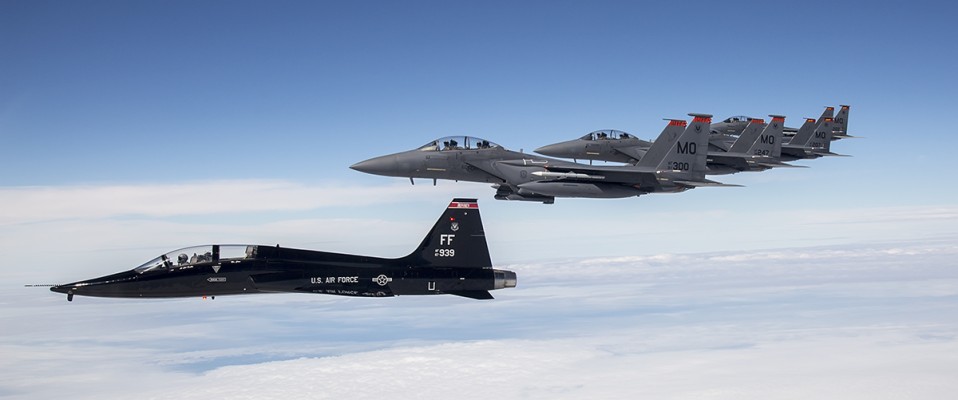Sit Down, Buckle Up and Fly with Red Air during Atlantic Trident ’17
A Personal Story of flying in a fast jet as a Red Air adversary
Story and images by Todd Miller
June 7, 2017
At 21,000 ft “Code” rolls the Talon inverted. I have just enough time to realize we are inverted – before the Gs started building and we are pointed… down. Straight down. We are flying adversary air in a 71st Fighter Training Squadron (FTS) T-38A Talon during Atlantic Trident ’17. Not your normal Red Air VUL, today we are facing off against a historic gathering of the most formidable fighter aircraft in the western world.
The United States Air Force (USAF) 1st Fighter Wing located at Joint Base Langley-Eustis (JBLE) hosted the event. 1st FW is responsible for 30% of the USAF Raptor fleet. Described as “America’s Premier Air Dominance Wing,” the 1st FW is elite company. This group (with the help of the 71st FTS) ensures the Raptors under their command are maintained, manned by skilled pilots, and ready to go when and where needed at a moment’s notice.
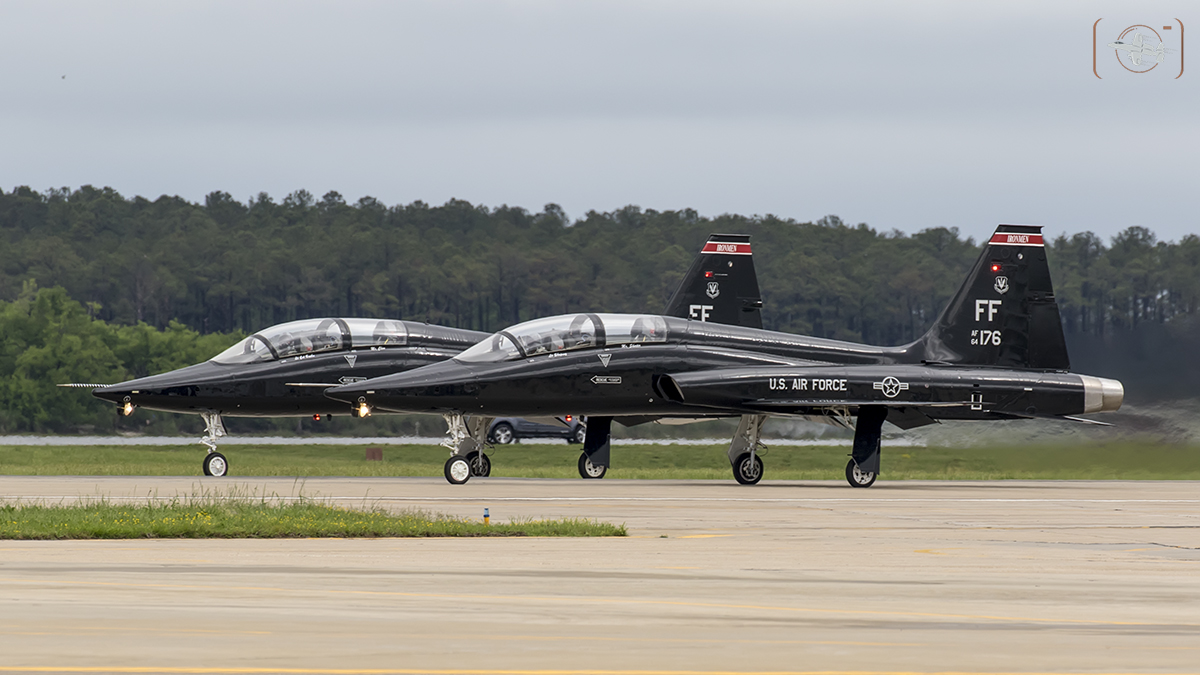
T-38As of the 71st FTS performing a rare side by side launch during a Atlantic Trident ’17 Vul, JBLE.
A flight in a fast jet is nothing like the flying most are familiar with. There is no TSA pre-check line to expedite travel, rather there are hours of required preparation prior to each flight. Having cleared the required medical, I spent 6 hours in training and equipment fitting prior to the flight. The training itself was primarily focused on ejection and subsequent survival – with several added details of systems I’d operate manually (for my own well-being) in the rear cockpit of the older Talons.
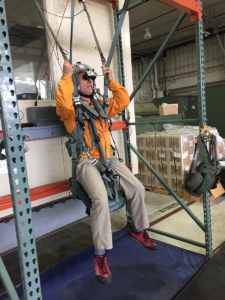
Virtual parachuting… so many things to keep in mind. We’re through the primary list and into the wind.
The outcome was a mind full of lists and procedures that I’d need to perform, and in the case of ejection – have too perform. The thorough training left me thinking far more about ejection than the probability of such an event occurring; body position; glance at altitude; pull ejection handles; once free from the seat and assuming conscious – activate emergency oxygen if required (above 14,000 ft); enjoy the scenery while waiting for the chute to deploy automatically; if chute did not deploy by an estimated 10,000 feet, be sure to pull the rip cord prior to contacting the ground…
But it didn’t stop there; once the chute deployed; validate I had a good canopy; if not, work specifically to untangle the cords and get a good canopy; up with the visor, off with the oxygen mask – dispose to avoid tangling; inflate the life vest; pull on the “riser handles” to cut the rear four lines and enable steering of the chute (unless of course I had previously used the specific tool to cut away tangled cords… ); steer into the wind for landing; assuming in our case a water landing (but keep in mind procedures required if landing on ground, trees, or through powerlines) prepare for splashdown.
Okay – we are in the water and somehow still aware and capable; get the chute off to avoid being tangled in it, release the chute harness (be sure not to do this step during the previous decent!); avoid the sharp buckles on the inflated life raft; and somehow in the choppy seas get out of the water and into the raft. Well if once can get that far, I think it would be good to just lay there and call it a day.
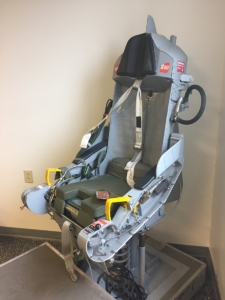
The Ejection seat, cavity for parachute, yellow ejection handles, and the entire raft and survival kit buried in the seat bottom.
After a brief rest; throw the raft stabilizer into the water to keep the raft from spinning; retrieve the floating survival kit tethered to oneself and the raft; crack open the survival kit; get the green dye into the water, locate the beacon, and survival radio and smoke / flare for rescue; activate the radio and make contact with help; then just relax, open the Perrier while waiting for the rescue helicopter. No worries, I got this.
However, regardless of an ejection – there are responsibilities that go with being in the backseat; ensure G-suit is on correctly and zippers pulled; chute straps tightened properly – validated if you can only walk like a duck (current fighter have the chute built into the ejection seat – in the Talon, the crew wear the chute), gloves available, ear protection, helmet and oxygen mask in hand; buckle in to seat bottom, then shoulder straps; attach the radio, oxygen and G-suit; validate oxygen system position; adjust rudder pedals to ensure my feet are not resting on them; interact with the pilot and ground crew while flight controls are being checked; when required pull and stow the pins for the canopy jettison and ejection handles; get my sick bag ready; adjust airflow – and do not delay the pilot!
The fact that I am writing this 5 weeks after my training provides an indication of its quality. The personnel who provided the training were professional, thorough and gracious.
Aside from taking care of the business, I was hoping to get some great photographs to document the flight. Of course, in the process it was critical not to drop anything that could potentially restrict the movement of any flight controls. No loose objects in the cockpit! I had lots to think about – and thanks to the weather, plenty of time to think about it.
All this preparation, and my flight Tuesday morning was scrubbed due to weather. There was no guarantee that it would be rescheduled – however the group at the 71st FTS were incredibly supportive. The afternoon slot that I was rescheduled into was also… scrubbed. Enough messing around with the weather, I was given a slot Wednesday afternoon when the weather should certainly be cleared.
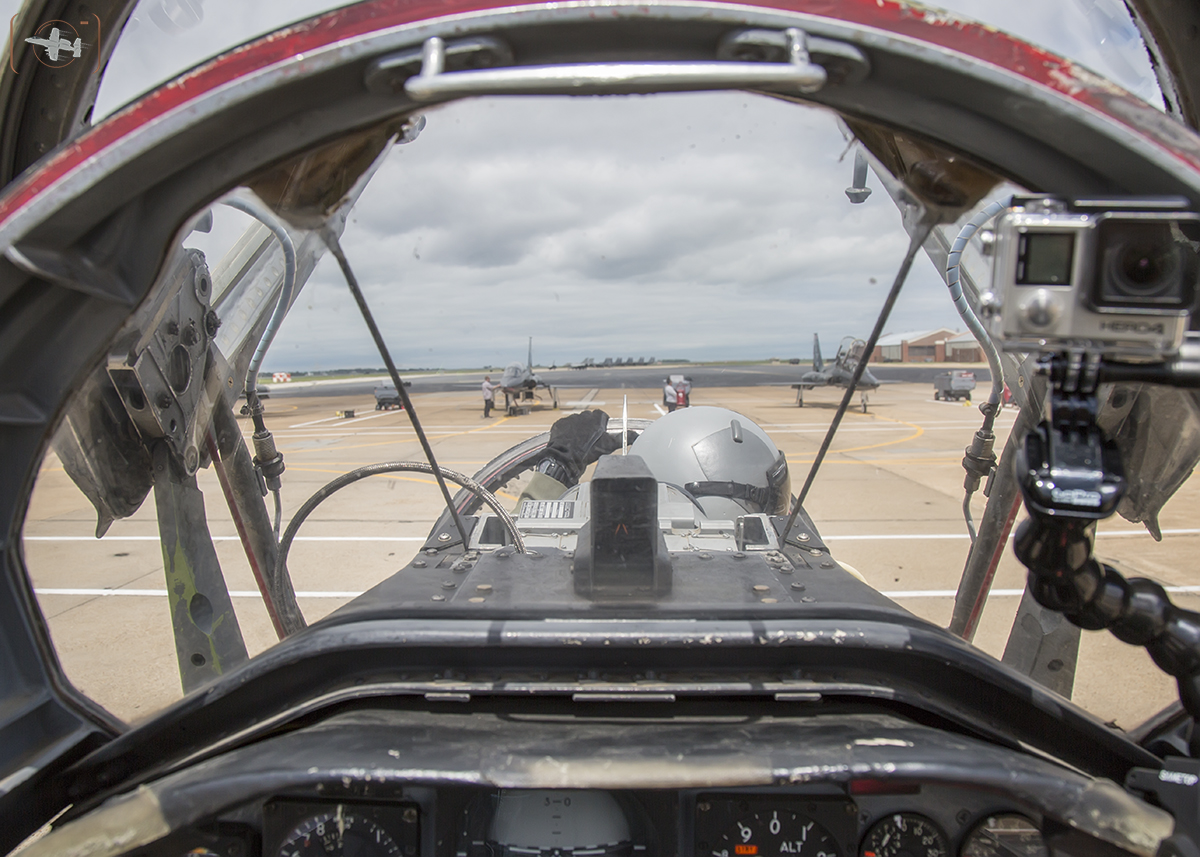
Settled in to the 71st FTS T-38A – watching Red (F-15Es) & Blue (Rafales) Air build up at EOR during Atlantic Trident ’17 – JBLE.
Wednesday morning arrived and after two days of rain and scrubbed VULs the clouds began to lift. The base roared to life with the whine of jet engines and rumble of launches. Everybody was ready to get into the air. I took the opportunity to head towards EOR to capture the morning launches – before heading to the briefing for my afternoon flight.
Now it was real, briefing on. A flight in a T-38, but not just any flight – the opportunity to participate in an actual Red Air vs Blue Air VUL. And not just any VUL – but one against the foremost fighter aircraft in the Western world! I did not expect that we would get eyes on Blue Air – but the reality of the mix was not dampened in any way.

F-22 Raptors of the 1st FW JBLE wait for launch clearance at the EOR during Atlantic Trident ’17.
The Platforms & Players;
Blue Air: 1st FW F-22A Raptors; Eglin AFB F-35A Lightning IIs; Royal Air Force (RAF) Eurofighter Typhoons; French Air Force/Armée de l’air Dassualt Rafales.
Red Air: 71st FTS “Ironmen” T-38A Talons; 391st FS “Bold Tigers” F-15E Strike Eagles from Mountain Home AFB, ID.
Given operational security, some of the following flight details are principally correct.
The six participating Talons flew in two flights of three, “Vodka” and “MIG”. The Strike Eagle flights “Marlin” and “Dagger” combined to form another 6 aircraft. 12 Red Air with E-3A Sentry support, against 16 Blue Air. Given Blue Air was farthest from JBLE and launched first, they enjoyed tanker support from the Armée de l’air KC-135, as well as US tanker units.
What could we expect of the VUL? Red Air understood that Blue Air was tasked with a strike mission (target location unknown to Red Air) using the Rafale and Raptor as strikers. While some might think the F-35As should have been the strikers, Raptor was the word and Raptors do have a very effective strike capability. The rest of Blue Air, Typhoons and Lightning IIs (and perhaps a mix of Raptors) were flying escort protecting the strikers.
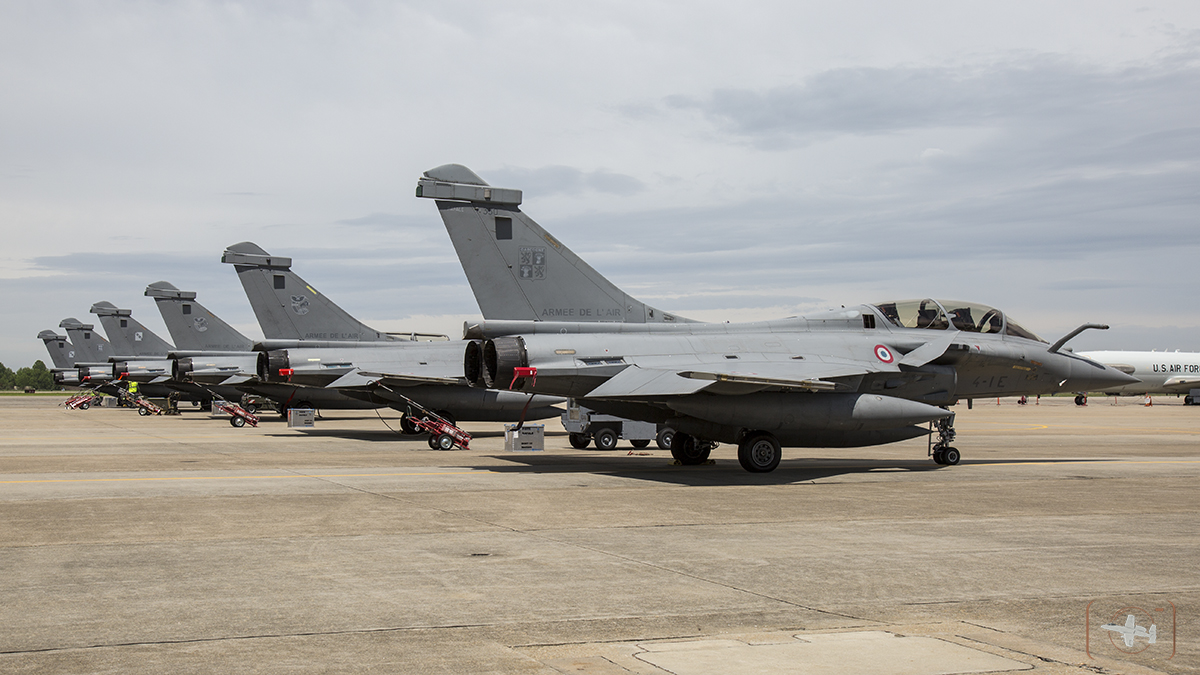
Dassualt Rafales of the Armée de l’air – French Air Force on the ramp at JBLE during Atlantic Trident ’17
Blue Air was challenged to employ “total force integration” across nationalities and platforms to form a multilayered, overlapping sphere of impenetrable “battlespace.” Blue Air would utilize their superior sensors to create a 3D picture of the battlespace and their state of the art weapons to “destroy” Red Air well beyond visual range (BVR).
Red Air would utilize dissimilar threats with specific missile emulations against Blue Air from a multitude of directions and altitudes. The Talons and Strike Eagles primary goal; to find the Blue Air strikers (call sign “Rogue”), penetrate the escorts to get within an effective (emulated) missile envelope and realize a kill. However, even if a visual on a Raptor or Lightning II was realized (and Red Air had the radar capability) they would still be “chasing a ghost” and could not expect to get a lock. Great.

F-35A from Eglin AFB moves towards launch for a vul during Atlantic Trident ’17 exercise held at Joint Base Langley-Eustis, VA.
While the scenario sounds like a futile effort for Red Air, it is key to understand that this exercise is not a game where the highest kills wins. Rather, the primary purpose of the exercise is to ensure Blue Air (our collective nations fighting edge) refine Tactics, Techniques and Procedures (TTPs). With common, familiar TTPs, the coalition will quickly come together in the face of a future conflict and be effective day one.
The coalition of Blue Air was challenged to maximize their mix to most efficiently use each aircraft’s exceptional capabilities, weapons loads and available fuel. The best efforts of Red Air would test the tactics of Blue Air to ensure they overlook nothing, and respond correctly to the dynamic of the fight. If a Blue Air participant required a learning lesson – it was up to Red Air to provide it and this was the right time and place to do so. Perhaps in the “fog of war” an area of the formation would be left uncovered, and Red Air would get a leaker through to do some damage.
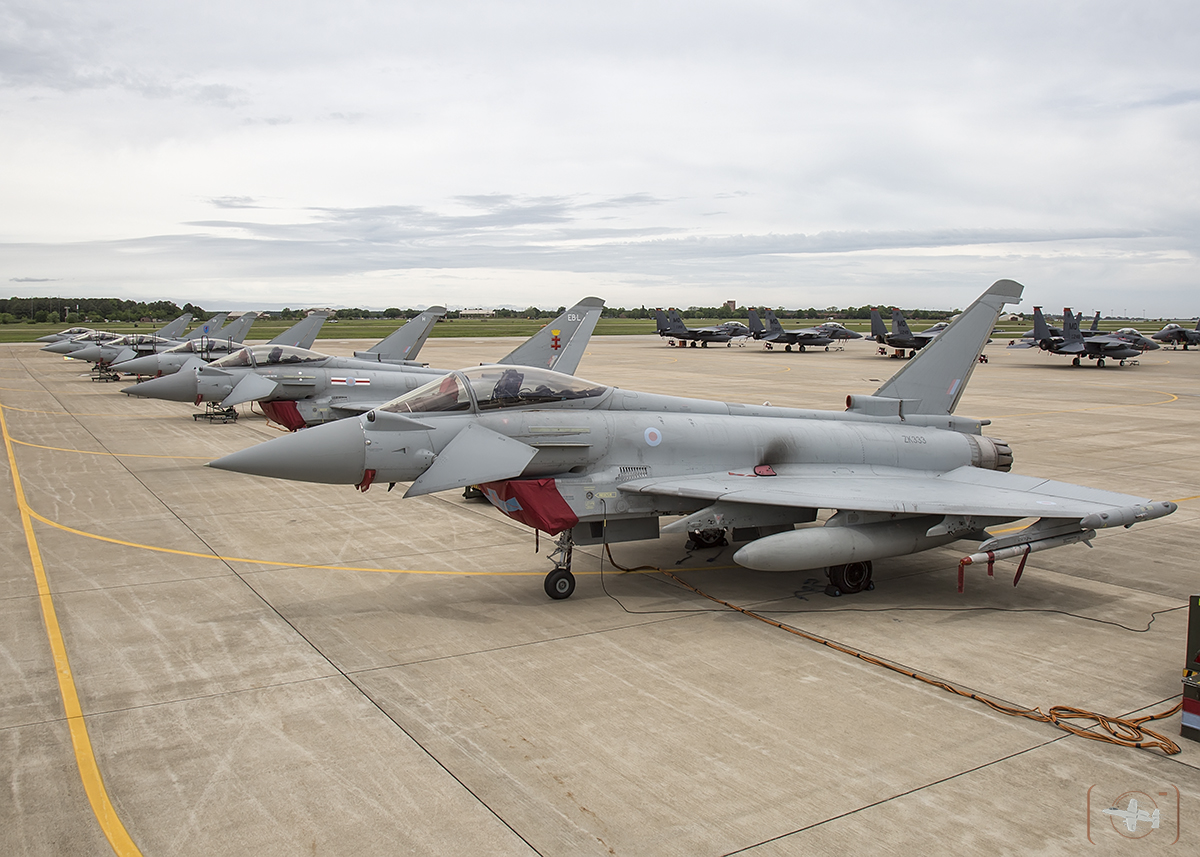
RAF Typhoons on the ramp with Strike Eagles at Joint Base Langley-Eustis during Atlantic Trident ’17.
The 71st FTS “Langley Adversaries” fields young pilots preparing for the Raptor as well as seasoned Raptor pilots and pilots with plenty of experience in alternate platforms. One look at the markings on the F-15E Strike Eagles of the “Bold Tigers” and it was clear there was plenty of combat experience in those cockpits. No question, this group of pilots had the ability to take down a Blue Air player. In a previous visit to the 71st FTS I met one of the T-38 pilots who had done that very thing. I expect it was a lesson that resonated with the Raptor pilot.
Following a briefing among the two Talon flights (Vodka & MIG) our specific flight (Vodka) discussed plans to form up prior to penetrating the low cloud cover to maximize formation time enroute the range. I’ll be back seat of Vodka 3 flown by “Code,” (1st Lt.) joining our flight lead Vodka 1 “Shim” (Maj.) and Vodka 2 “HOTAS” (Maj). With launch time bearing down we moved to the crew ready room to gear up, flight suits, boots, G-Suits, parachute with helmet & oxygen mask in hand and it was off to the aircraft.
All the checklists vanished as I made a specific effort to appreciate the walk across the ramp to the aircraft. This is a walk I have longed to make for as long as I can remember. Strapping into a fast jet takes a tremendous amount of support and preparation. Behind that row of Talons stood scores of people and a complete Air Force that strives for excellence. It was a privilege to climb the ladder and strap in – with Code’s assistance.

View from Langley Adversaries, 71st FTS “Ironmen” Vodka 3, lined up beside Vodka 2, 1 & MIG flight. The F-15Es of Marlin and Dagger flight are leaving EOR and launching. Red Air is on the way, during Atlantic Trident ’17 flying out of Joint Base Langley-Eustis.
I plowed through my mental checklist, and interacted with Code as he worked through his. I may be along for the ride – but there were aspects I was responsible to handle. Within minutes we were rolling towards end of runway (EOR). As we taxied the last of Blue Air was launching, like high strung race horses finally released from the gates they roared into the air off to the fight.
At EOR we pull into line with MIG flight and our Red Air teammates, F-15Es from the 391st FS. The ground rumbles as the Eagles launch in ‘burner – brute force, proven capability. MIG flight follows and our flight launches last, one at a time in rapid succession. Vodka 3, is last to launch. We taxi onto the runway and Code pushes the throttles forward and the Talon lurches forward accelerating smoothly and lifting off into the sky.

Sliding in under T-38As of Langley Adversaries, 71st FTS “Ironmen” Vodka 1 & Vodka 2 during Atlantic Trident ’17 range bound.
We form up with Vodka 1 and 2 at 2000 ft and punch into the clouds in formation. Within seconds we break through the clouds and the Talons dance beside us, beautiful black darts in the blue sky. Ironmen. The SR-71 Blackbird clearly established that “black jets” are the coolest, so the Ironmen are fine company. The aircraft are stable and the pilots smooth. We stay in formation as we climb to altitude on the way to the fight. There is no sensation of speed. The wings are behind me out of sight – I simple sit in a “tube” with a fantastic view – suspended in the sky. From time to time the tube rotates and the very real forces that apply themselves to the body make it clear that this is very real.
MIG flight is now far to the southeast working the opposite flank. Marlin and Dagger are well above us in their own airspace blocks working the higher altitudes. Red Air is tightening the noose. At altitude and nearing our block, Vodka 1 indicates he will run in on Blue Air from 10,000 ft below us. He drops away so fast my perspective is forever altered. A high-performance aircraft allows the pilot to carve the sky at will, shrinking time and space in ways grounded mortals cannot know.
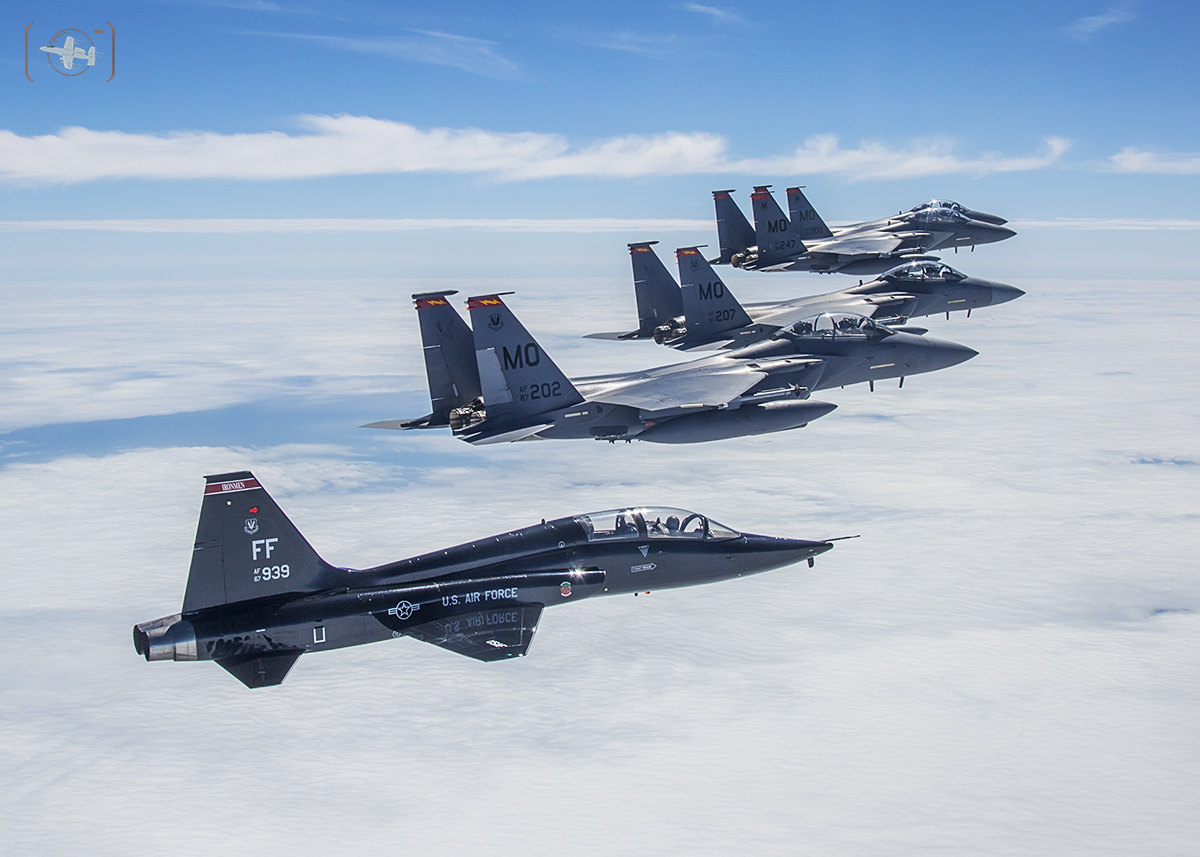
71st FTS Ironmen T-38A (Vodka Flight) and 389th FS Thunderbolts/391st FS Bold Tigers F-15Es (Marlin & Dagger flights) RTB after Atlantic Trident ’17 Vul.
With “go time” quickly closing in, Vodka 2 moves some distance from us. Flying almost parallel we form a “wall” approaching Blue Air. Red Air is attacking in numbers from many different directions and altitudes. Perhaps Blue Air will miss one of us as we close rapidly and a striker will fall!
We now appear to be alone in the sky, a single gunslinger in the expanse with weapons armed and ready against impossible odds. Focus and activity keep the thought at bay, the controllers voice a clear reminder that we are part of a much greater force and we do not fight alone.
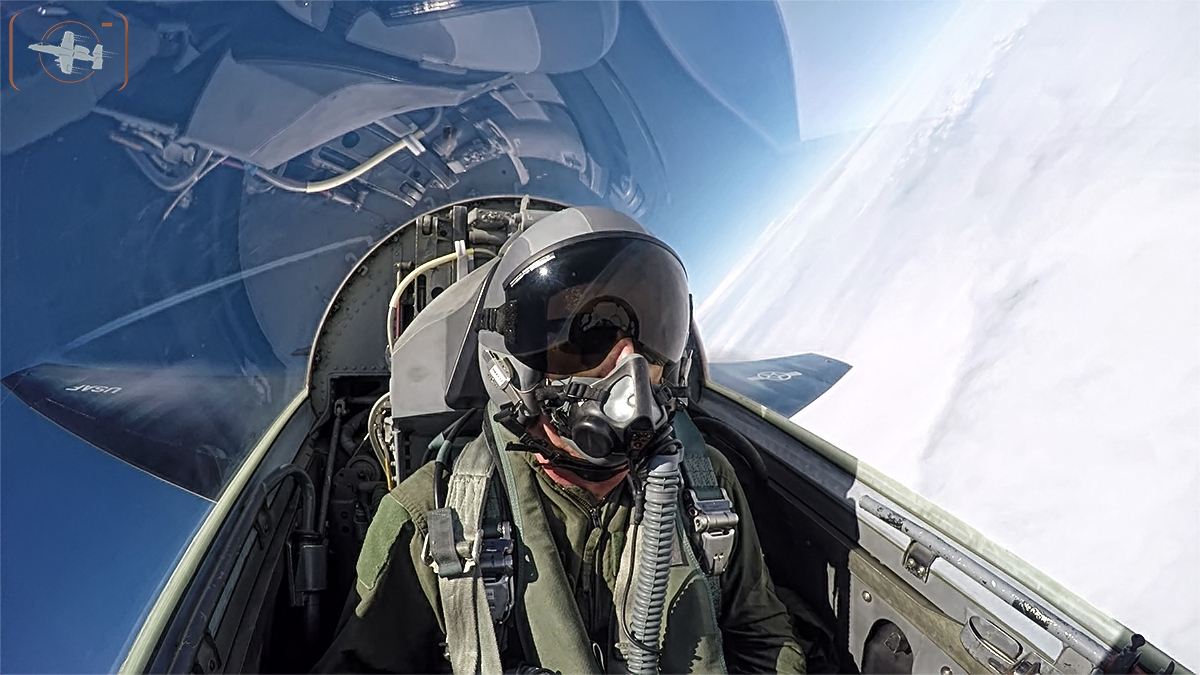
The fight is on! Red Air pulling G with the 71st FTS “Ironmen” T-38 Talon flown by “Code.”
“Fights On!” We fly our vector, oblivious to the invisible danger that lurks unseen in the distant (or near) sky. The next 45 minutes is filled with intensity driven by communications and our own maneuvers. The controller calls a heading, we turn – someone turns, there is a lot going on in the skies. The tempo increases, the radio crackling with voices. Controllers in the E-3A are busy directing and working what sounds like play by play of an intense play-off game. An intense play-off between warfighters.
Through the intercom, Code warns “G’s!” I have split second to prepare for a snap turn and the onset of G’s. Code is kind, the G’s are short lived and light – well under 3. Within moments I hear the radio crackle, “Vodka 1 you’re dead,” followed by “Vodka 2 you’re dead.” Our flight is being picked off like tin cans on fenceposts. I wait to hear Vodka 3 you’re dead – but silence. I can’t believe we are not yet dead and it would be ridiculous to actually get into the kill envelope vs Blue Air. Marlin 1, Dagger 2 you’re dead.” No, No – not the Strike Eagles! The comms crackle in warfighter shorthand, best deciphered by those who speak in this language. With a sense of the inevitable, I hear it “Vodka 3 you’re dead.” No sympathy, just cold, matter of fact. It is done. I don’t know what killed us, but we were shadow boxing with a lethal foe.
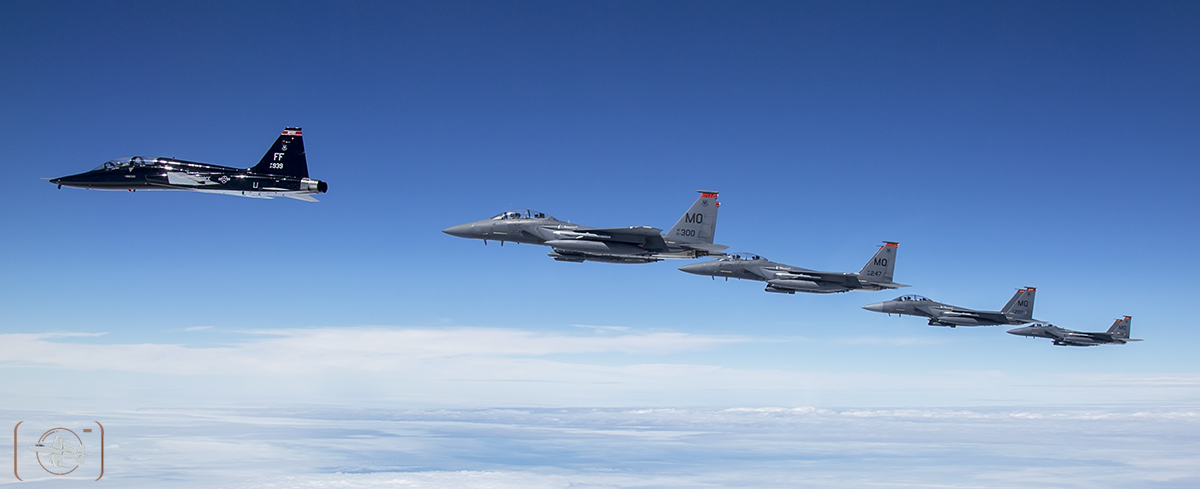
71st FTS Ironmen T-38A (Vodka Flight) and 391 FS Bold Tigers F-15Es (Marlin & Dagger flights) RTB after Atlantic Trident ’17 Vul. 2 F-15Es bear the markings of the 389th FS “Thunderbolts”, however I believe they were flown by 391st crew.
As we turn to regenerate it is clear this is not a fair fight. That is the point and why the tremendous investment in the 5th Gen aircraft. The USAF has no intention to fight fair, they have built their force to dominate the air. They who own the air will find it much easier to own the ground and sea. Looking straight up far above us I see a silver spec blazing across the sky contrail in tow at what appears to be supersonic speeds. A Raptor? It flies with impunity, we are mere spectators. If this was a real fight, seeing such a sight would be a signal to any adversary – RTB (return to base). Quickly.
After regen we return to the fight flying a designated vector. In an instant, Code rolls the Talon inverted and pulls briefly into a vertical descent and then a great diving arc. I had about as much as 1/10th a second to prepare for that, and 1/5 a second to enjoy it. Thank-you very much. At some point, we pull near 4G, and the prospects have my undivided attention; will I weigh 1000 lbs today, or just 750?
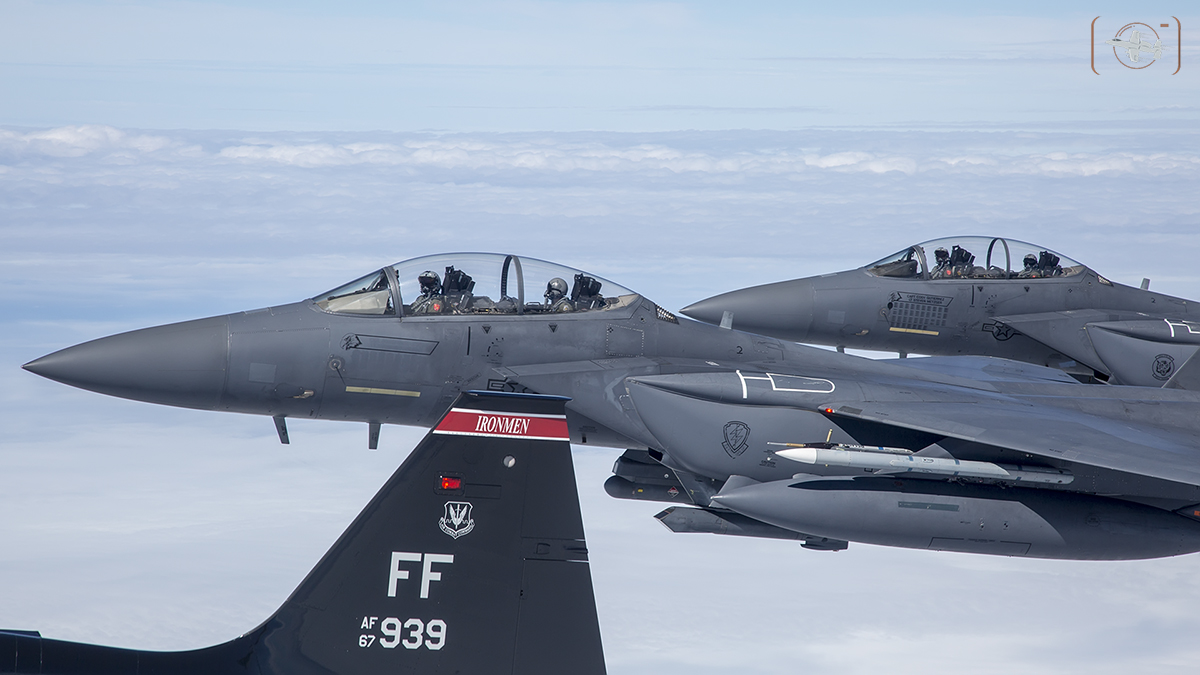
An “Ironmen” of the 71st FTS hanging with F-15E Strike Eagles of the 391st FS Bold Tigers F-15Es RTB after Atlantic Trident ’17 Vul.
I am told the pilots generally do not note the physical, their muscle memory kicks in to activate the required physical response while their mind is focused on the battle. I am glad to hear that, I’d certainly hate to lose my train of thought in such a time and place. The Talon bottoms out 10,000 ft below where the maneuver started, and we quickly climb all the way back to 20,000 ft.
It takes a minute to perform the massive maneuver. This is what it means to carve the skies, shrinking time and space.
And then I believe I hear it – “Rogue 1 you’re dead.” Did we get a Blue Air Striker? Perhaps for all the Red Air jets that fell – perhaps we got one… It is not for me to know or confirm, that is business that takes place in the debriefing.
45 minutes’ pass in the VUL, and we break for JBLE. Code directs me to the right. Four F-15Es descending from much higher altitude are sliding together in formation. “Bold Tigers,” “Ironmen,” their squadron names alive in this space, man and machine one to a purpose.
In tight formation, the Strike Eagles of Marlin and Dagger flights bob up and down like parts of a living being. Magic. Magic always ends leaving you wanting more, that’s how you know it is magic.
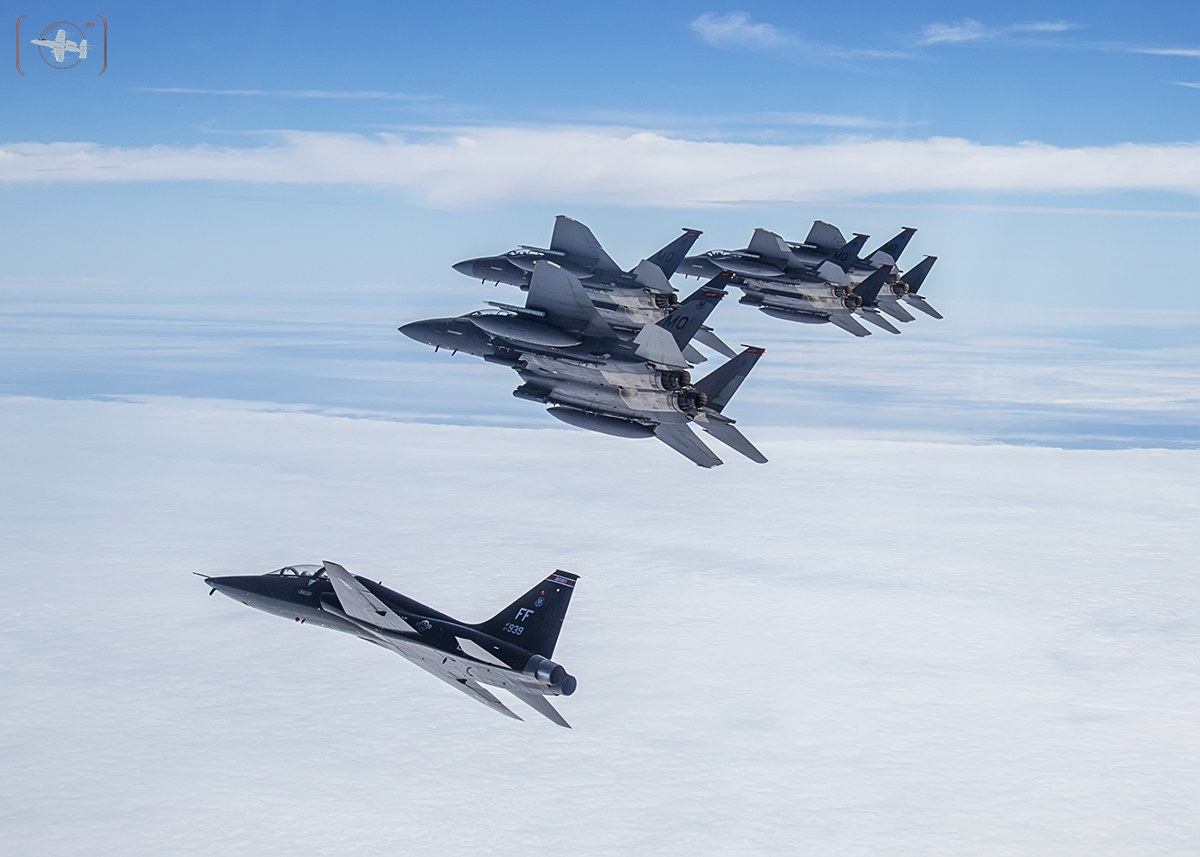
71st FTS Ironmen T-38A (Vodka Flight) and 391st FS Bold Tigers F-15Es (Marlin & Dagger flights) RTB after Atlantic Trident ’17 Vul.
Some may ask, “What is it like to fly adversary against the most lethal integrated fighter force on the planet?” My answer, “You just die. Sight unseen. You just die.” Bury your pride, and get used to dying. But do not forget, your “death” serves a greater purpose. The seemingly futile fight and subsequent “deaths” are critical to ensure the readiness of the cutting edge of our warfighters, and “Total Air Dominance.”
Aviation Photography Digest expresses gratitude to Jeffrey Hood 633 ABW PA and the entire 633 ABW Public Affairs Team who were instrumental and exceptional with their support; Col. Pete “Coach” Fesler, 1 Fighter Wing Commanding Officer, and the 71st FTS, pilots, support, medical and others were beyond exceptional hosts. The entire team at Joint Base Langley-Eustis, professional and gracious throughout the visit. You set the bar, we can but hope to capture and share a small reflection.

T-38A of Langley Adversaries, 71st FTS “Ironmen” Vodka 1 & 2 during Atlantic Trident ’17 range bound. Flying out of Joint Base Langley-Eustis.

Back on the ramp and climbing out of “my ride,” an 71st FTS T-38A Talon. A rare, and much appreciated time on the ground and in the air with the Ironmen, the supporting personnel of the 71st FTS/1st FW, and the entire team at JBLE!

In tight with Vodka 1 & 2, T-38A Talons of the 71st FTS as we are just breaking out of cloud cover during Atlantic Trident ’17 Vul, JBLE.

71st FTS Ironmen T-38A (Vodka Flight) and 391 FS Bold Tigers F-15Es (Marlin & Dagger flights) RTB after Atlantic Trident ’17 Vul. 2 F-15Es bear the markings of the 389th FS “Thunderbolts”, however I understood they were flown by 391st crew.
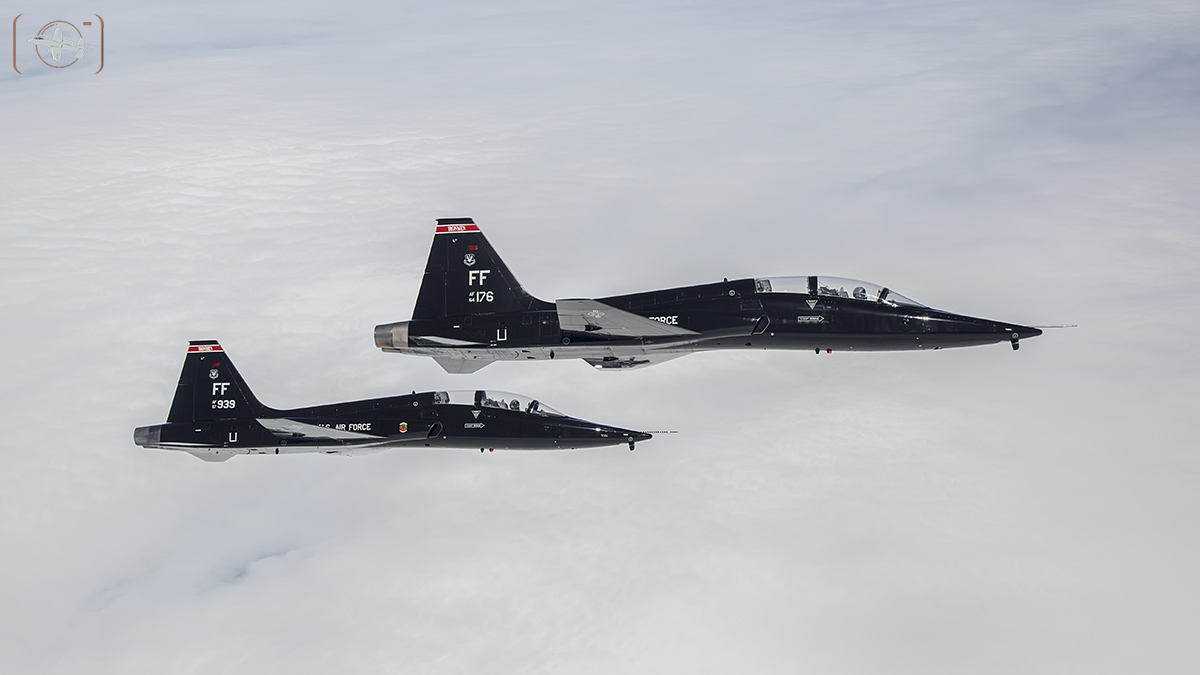
Vodka 1 & 2 off the wing of Vodka 3 during Atlantic Trident ’17. 71st FTS “Ironmen” Langley Adversaries getting ready to go to work.
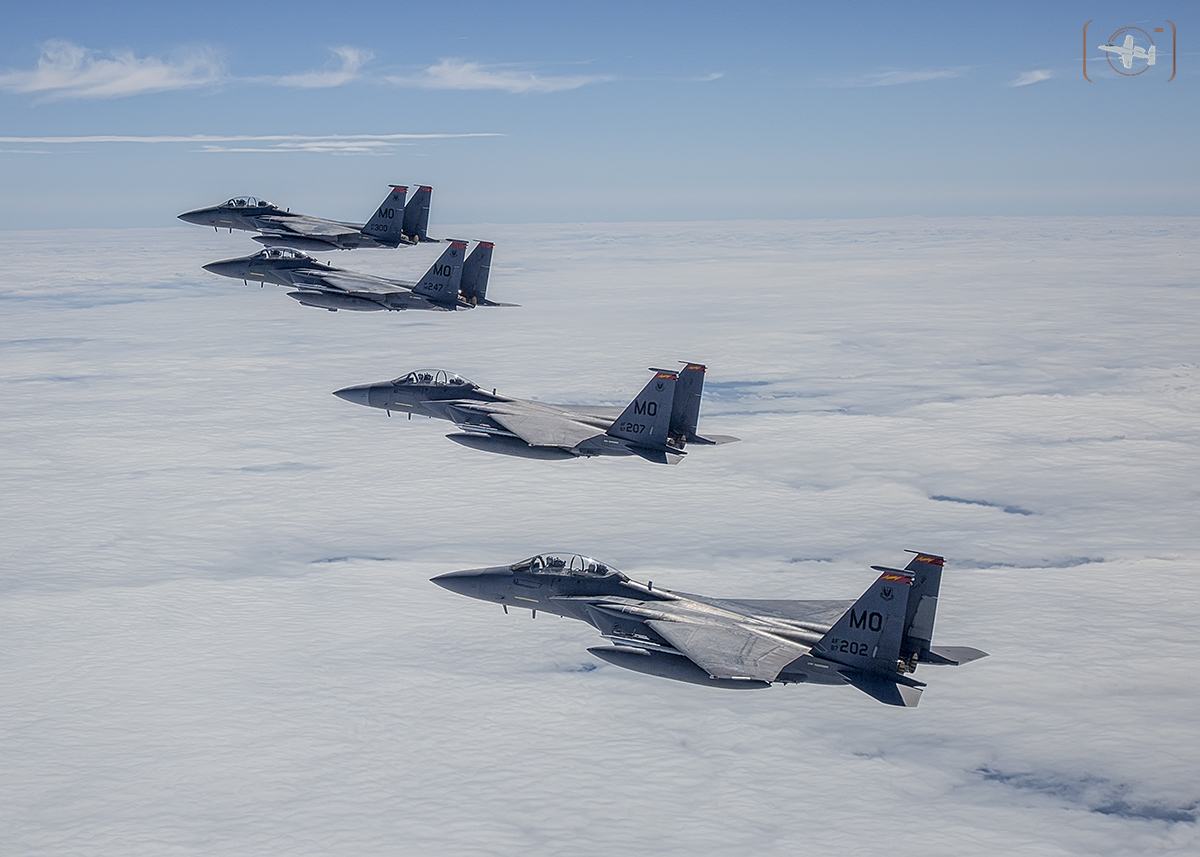
F-15E Strike Eagles of the 389th FS Thunderbolts/391st FS Bold Tigers F-15Es (Marlin & Dagger flights) RTB after Atlantic Trident ’17 Vul.
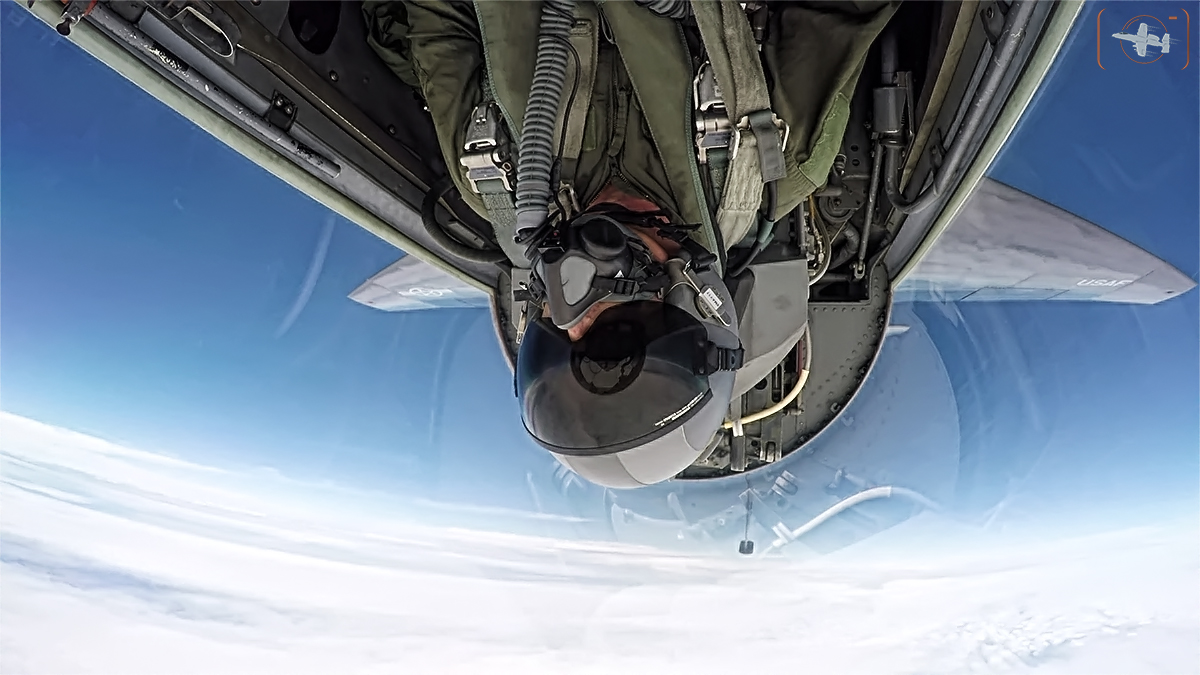
The fight is on! Red Air Vodka 3 inverted and going for a 10,000 ft drop with the 71st FTS “Ironmen” T-38 Talon flown by “Code.”
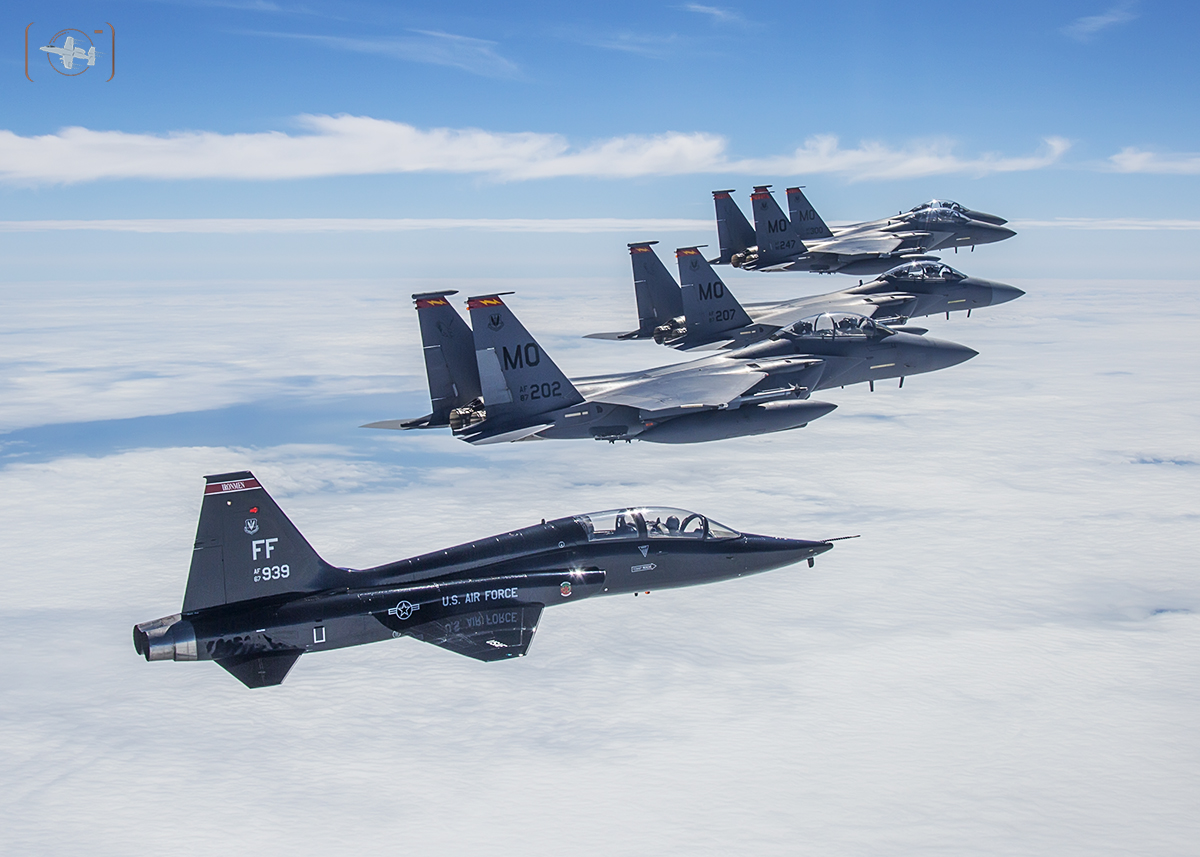
71st FTS Ironmen T-38A (Vodka Flight) and 389th FS Thunderbolts/391st FS Bold Tigers F-15Es (Marlin & Dagger flights) RTB after Atlantic Trident ’17 Vul.
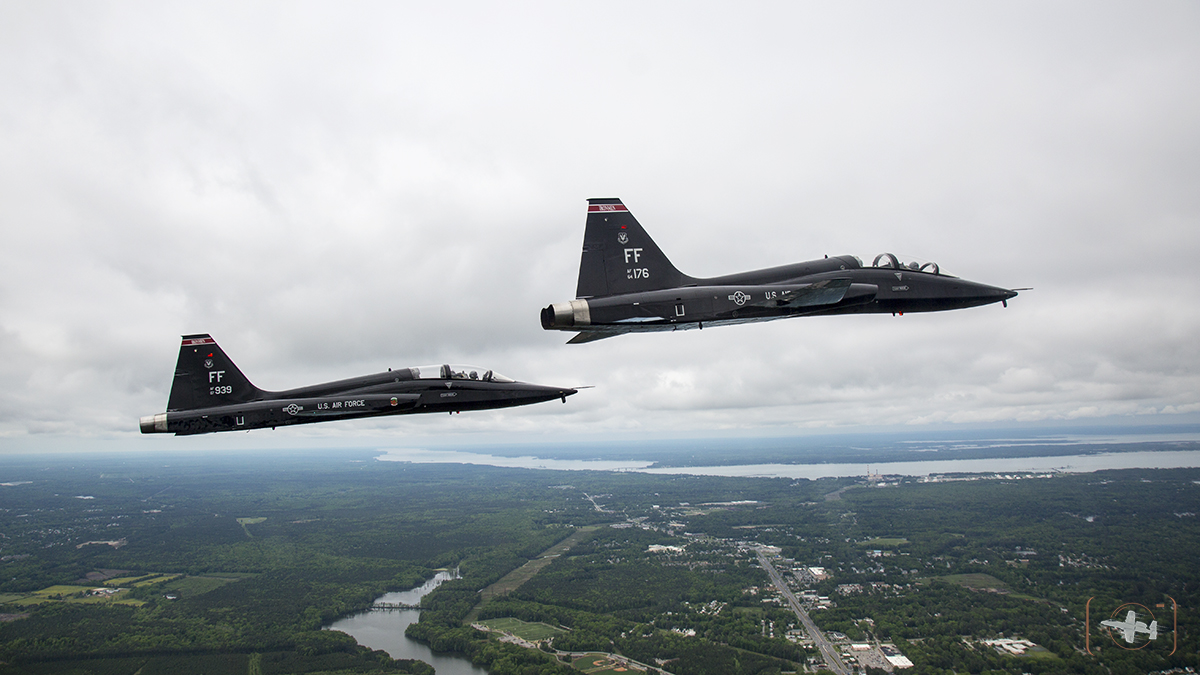
Forming up on Vodka 1 & 2 prior to entering low cloud cover. T-38A of Langley Adversaries, 71st FTS “Ironmen” during Atlantic Trident ’17 range bound. Flying out of Joint Base Langley-Eustis.

Blue Air Dassualt Rafale of the Armée de l’air – rolls by on the way too launch while we settle in to our Red Air T-38A Talons (71st FTS) at JBLE during Atlantic Trident ’17
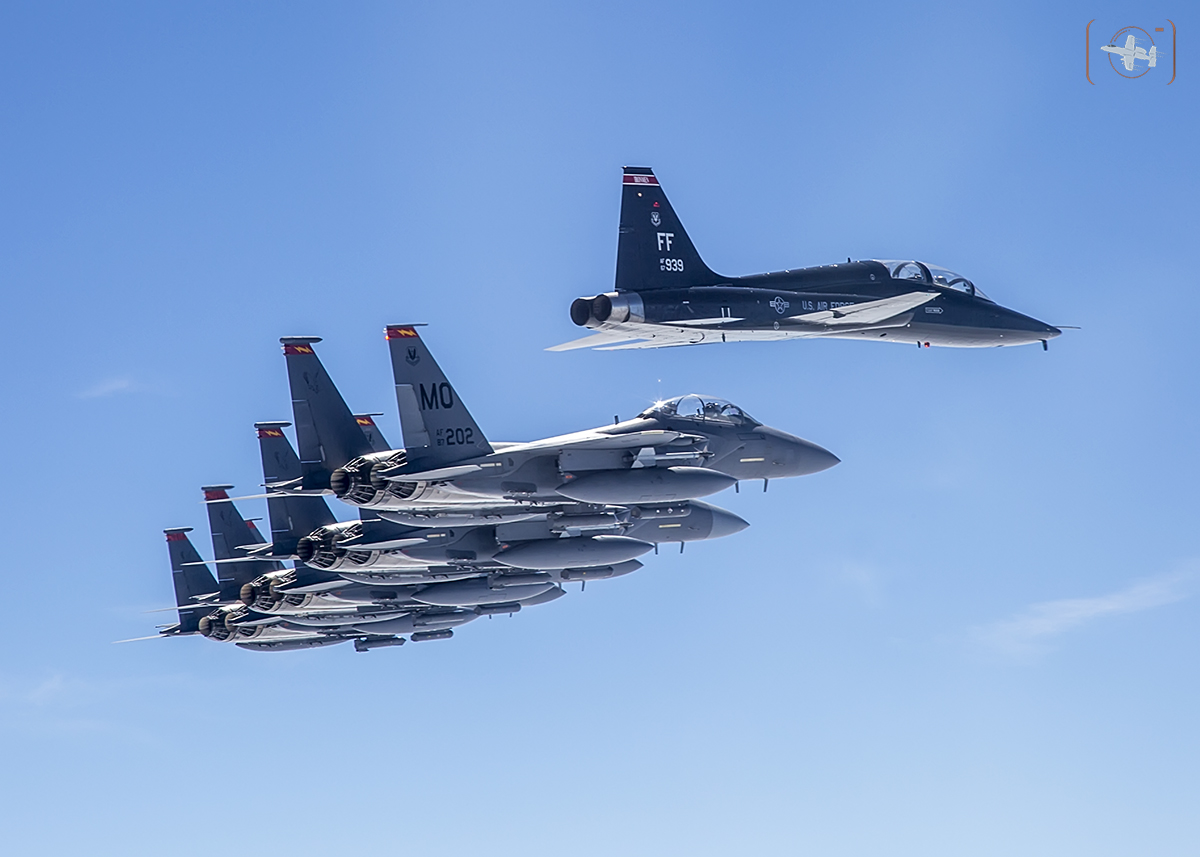
A portion of the Atlantic Trident ’17 Red Air – F-15Es of the 391st FS “Bold Tigers” (Marlin & Dagger Flights) and T-38A of the 71st FTS “Ironmen” (Vodka Flight) RTB after vul.
Click on an image below to page or swipe through the gallery:


